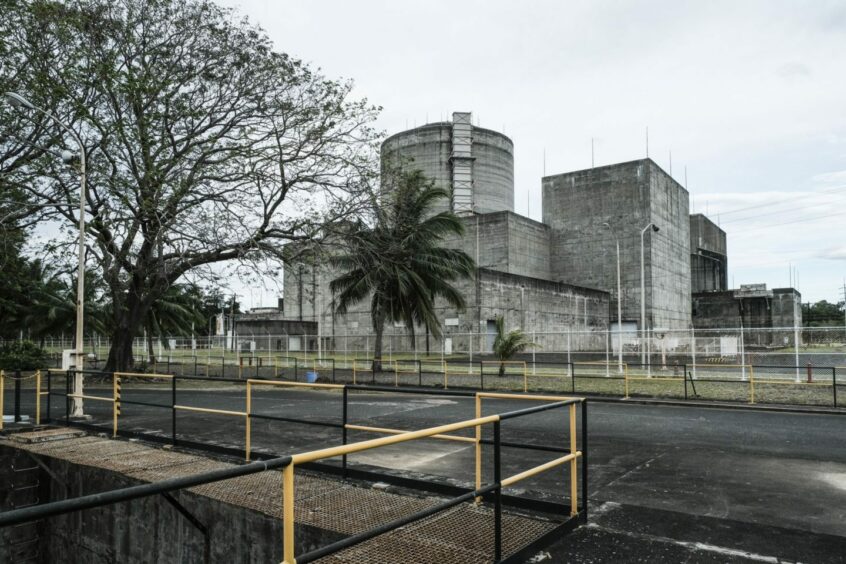 © Photographer: Veejay Villafranca
© Photographer: Veejay Villafranca A nuclear power plant on the Philippines’ western coast has sat idle for nearly four decades, costing billions of dollars and never producing a watt of electricity. Now, it’s at the center of a debate over whether the nation should finally adopt atomic energy.
Dictator Ferdinand Marcos ordered construction of the 620-megawatt Bataan facility in response to the oil shock in the 1970s, the first and only one of its kind in Southeast Asia. Beset with safety concerns and corruption allegations, the completed project was ultimately mothballed after Marcos was ousted in 1986. The six presidents who followed all decided against commissioning it, deterred by nuclear disasters, local politics and court cases.
But with the former strongman’s son Ferdinand Marcos Jr. winning the presidency earlier this year, the Philippines is taking another look at restarting the plant — and fulfilling his father’s nuclear ambitions — as the oil-importing nation looks for ways to shield itself from a global energy supply crunch.
A decision on whether to commission the plant “can be done soon enough,” possibly within Marcos’s six-year term, Energy Undersecretary Sharon Garin said in an interview. “We are not discarding the Bataan plant, but we have to make sure that it’s safe to revive,” she said. The government plans to hire a third-party evaluator next year to check the viability of the facility.
A nuclear plant the size of the one in Bataan operating near peak capacity would have generated about 5% of the Philippines’ power needs last year, according to calculations based on BloombergNEF data. Coal accounted for 60% of electricity generation while the country’s declining gas supplies contributed another 17%.
The revival of the Philippines’ nuclear ambitions is part of a broader global push to tap the energy source amid a shortage of gas sparked by the Ukraine war. Concerns about global warming have also renewed interest in the carbon-free technology. Japan and South Korea are removing anti-nuclear policies, China and India are looking to build more reactors, while France and Finland are set to restart some nuclear facilities.
‘We Need All We Can Get’
As for the Philippines, Marcos Jr. has said he wants the country to have at least one nuclear power plant. He recently met with South Korean President Yoon Suk-yeol to discuss possible cooperation on the Bataan plant. “We’re looking at what’s the most attractive source of power generation,” Marcos said during a Bloomberg TV interview in September. “We need all we can get.”
Public opinion polls indicate widespread support for nuclear facilities. A June survey by pollster PUBLiCUS showed 59% of Filipinos in favour of building a nuclear plant. A separate survey by the Energy Department and pollster Social Weather Stations in 2019 showed 79% of respondents approved of reviving the Bataan facility.
Some living around the plant are also in favour of reviving it. Emily Miguel, 54, who runs a store nearby, thinks turning the facility on will boost the local economy. “If anything bad happens with the plant, we can just evacuate then, but we need jobs now,” she said.
Church officials in the predominantly Catholic nation have long opposed the plant’s revival, however. Academics, including Marcos’s Science Secretary Renato Solidum, have also previously warned that the facility is located in an area prone to earthquakes and close to two volcanoes.
“The stance of Bataan is not to accept 40-year-old technology that has a lot of risks,” Albert Garcia, one of the province’s congressional representatives, said at a recent hearing. The local government has already received proposals to turn the plant into a data center, he said.
Urgent Need for Energy
As officials weigh the opposing views, the Philippines is in urgent need of new sources of energy. A key gas field expected to dry up within five years and power costs among the highest in the region are discouraging investors.
“History has proven the president’s father correct: if we used the nuclear plant, we will not have these problems,” said lawmaker Mark Cojuangco, who heads a congressional committee on nuclear energy. “Now he has to take a stand and finally fight for this.”
Reviving the plant would come with a $1 billion price tag, based on a 2019 study by Korea Hydro and Nuclear Power Co. While a handful of workers are employed at the site to maintain the structure, four decades of it lying dormant have taken their toll. The facade with streaks of rust and crumbling concrete needs upkeep, and the analogue equipment inside has to be updated. Other options include building a new plant, or waiting for small modular reactors to be a viable technology.
Even with the president’s support, nuclear would have to compete with a growing solar sector, with costs in the Philippines already on par with coal power and forecast to halve by the end of the decade. Billionaire Enrique Razon recently announced plans for a massive solar-and-battery facility that would be able to supply electricity for cheaper than current wholesale prices.
